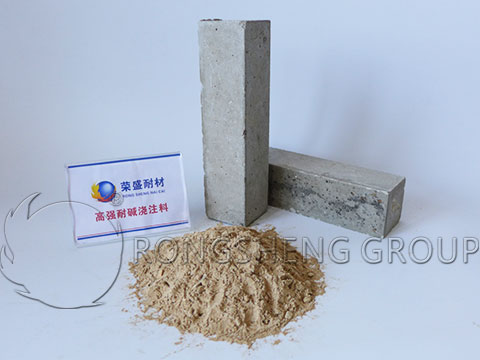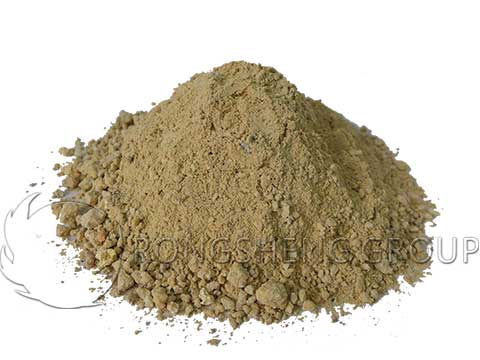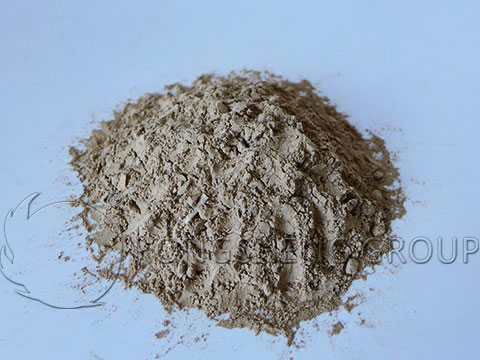The Differences in Performance between Lightweight and Heavy Alkali-Resistant Castables
Castable refractory materials that can resist the corrosion of alkali metal oxides (such as K2O and Na2O) at medium and high temperatures are called alkali-resistant refractory castables. The composition of this type of castable is similar to the castable combined with ordinary calcium aluminate cement. It is a mixture composed of alkali-resistant refractory aggregates and powders, binders, and additives. Rongsheng refractory manufacturers will start with the classification of alkali-resistant refractory castables and show you the differences in performance between lightweight and heavy alkali-resistant castables.

Classification of the Alkali-Resistant Castables
According to the use environment and conditions, alkali-resistant refractory castables are divided into lightweight and heavyweight (also called the dense castable). Those with porosity greater than 45% are lightweight alkali-resistant castables, and those with porosity less than 45% are heavy alkali-resistant castables. The heavy ones can be divided into medium-temperature alkali-resistant castables and high-temperature alkali-resistant castables.

Lightweight alkali-resistant refractory castable
The aggregates used in the lightweight alkali-resistant refractory castables include alkali-resistant ceramsite, clay porous clinker, waste porcelain, high-strength expanded perlite, etc., and the binder is calcium aluminate cement or water glass. High-silica refractory materials can be used as alkali-resistant materials. This type of material will react with alkali metal oxides to form a high-viscosity liquid phase at high temperatures to form a shafted dense protective layer to prevent further penetration and erosion of the alkali metal melt. Its chemical composition is generally: Al O 30%~55%, SiO 25%~45%. The traditional alkali-resistant castable cement dosage is 25%~30%, and the amount of water added is 20%~25%. Due to the destruction of the cement glue structure at medium temperature (800~1000℃), the strength is greatly reduced, which is only about 50% of the drying strength. Therefore, it is possible to introduce ultra-fine powder and suitable dispersant, the amount of cement is reduced to 10%-20%, and the amount of water added is reduced to 15%-20%.
The physical properties of typical low cement lightweight alkali-resistant refractory castables are as follows:
- The temperature is 110℃, 16h drying, the bulk density is 1.5~1.6g/cm3, the flexural strength is 3~6MPa, and the compressive strength is 30~40MPa.
- After firing at a temperature of 1100°C for 3 hours, the bulk density is 1.4~1.5g/cm3, the flexural strength is 6.0~6.5MPa, the compressive strength is 40~45MPa, and the linear change rate after firing is -0.3%~-0.5%.
- The temperature is 350℃, and the thermal conductivity is 0.4~0.5W/(m·K).

Heavy alkali-resistant refractory castable
The aggregates used in heavy alkali-resistant refractory castables include bauxite clinker, clay clinker, etc. The binder and alkali-resistant powder are the same as the light alkali-resistant castables. Its main chemical composition is Al O 35%~60%, SiO 35%~60%. The traditional heavy alkali-resistant refractory castable cement uses 20% of the material, and the amount of water added is 10% to 15%. Low cement type heavy alkali-resistant refractory castable cement content is 5%~15%, and water content is 6.5%~7.5%. Low cement heavy alkali-resistant refractory castable binder adopts calcium aluminate cement and silica powder (silica soot). The addition of silica micro powder not only helps to improve the medium temperature bonding strength of the castable but also helps to form an impermeable shaft layer on the surface of the castable lining during use. Its characteristic is that the strength after firing at medium temperature (1000~1200°C) is equivalent to that after drying (110°C), and the alkali corrosion resistance is good.
The physical indicators of typical low cement heavy alkali-resistant refractory castables are as follows:
- The temperature is 110℃, 16h drying, the bulk density is 2.20~2.59g/cm3, the flexural strength is 4~8MPa, and the compressive strength is 40~60MPa.
- After firing at a temperature of 1100℃ and 3h, the bulk density is 2.20~2.40g/cm3, the flexural strength is 6~10MPa, and the compressive strength is 35~55MPa. The linear change rate after burning is -0.3%~-0.4%, and the thermal shock stability (1100℃ water cooling) is greater than 20 times.
- The temperature is 350℃, and the thermal conductivity is 1.2~1.3W/(m·K).
What are the main raw materials used in alkali-resistant castables?
The aggregates used in the lightweight alkali-resistant refractory castables include alkali-resistant ceramsite, clay porous clinker, waste porcelain, high-strength expanded perlite, etc. The binding agent is calcium aluminate cement or water glass.
The aggregates used for heavy alkali-resistant refractory castables include clay clinker and waste porcelain materials. The binder and alkali-resistant powder are the same as the lightweight alkali-resistant castable. The binder generally uses calcium aluminate cement.
What is the alkali resistance mechanism of alkali-resistant castables?
The alkali-resistant mechanism of alkali-resistant castables is that they will react with alkali metal oxides at high temperatures to form a high-viscosity liquid phase to form a glazed protective layer to prevent penetration and erosion of alkali metal melts.
What are the suitable furnace parts for alkali-resistant castables?
Heavy alkali-resistant castables are mainly used in the kiln tail, kiln head, preheater, discharge port, tuyere, and other parts of the roasting alumina rotary kiln and cement rotary kiln. Lightweight alkali-resistant refractory castables are mainly used for the preheater top cover, cylinder body, and kiln insulation lining of the above-mentioned rotary kiln. Alkali-resistant castables can also be used in industrial kilns with alkali corrosion in steel, non-ferrous, glass, machinery, petrochemical, and other industries.

Rongsheng Refractory Castables Manufacturer
Rongsheng refractory castable manufacturer has rich experience in production and sales. Rongsheng has an environmentally-friendly, advanced, and fully automatic monolithic refractory materials production line with an annual output of 80,000 tons. Our unshaped refractory materials mainly include various types of conventional refractory castables, refractory plastics, refractory ramming materials, as well as various wear-resistant castables, wear-resistant ramming materials, and wear-resistant plastics. They serve the refractory lining of thermal furnaces with their own unique advantages. Whether it is in emergency hot repair, or you need to shorten the furnace repair period, or you need to customize monolithic refractories with special needs, we can provide you with monolithic refractory materials products that best suit your production needs. To learn more about Rongsheng’s unshaped refractory products, please leave your specific needs on our website page, and we will provide you with services according to your specific needs.